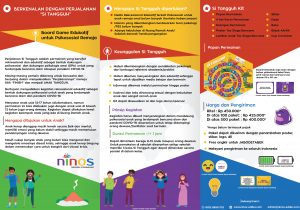Creating a child protection system within the education unit is an important step when we consider how a third of a child’s time each day is spent at school. Children spend most of their time studying at school. Thus, a school is a child’s second home. As a place of education, schools must provide a safe and comfortable environment for children. However, contrary to the previous statement, a school environment is where children are at most risk of experiencing violence.
According to various studies, violence continues to be perpetrated by students, educators, and other school personnel. Additionally, if cases of violence occur, children do not know where to report it.
Therefore, the Education Quality Assurance Council (Lembaga Penjamin Mutu Pendidikan, LPMP) in West Sulawesi took the initiative by cooperating with Ninos Nayaka Nusantara to conduct a workshop to build the capacity of educators from various levels of education. This workshop adapted the theme of Child Protection in Schools and was conducted for four days. The facilitators for this event were Mrs. Roganda Sadani Ukur Solin and Mrs. Christine Lora Egaratri. Furthermore, the objectives of this workshop include: Disseminating the Convention on the Rights of the Child and also policies related to child protection in educational units; providing awareness of the importance of child protection in education through the application of positive discipline; understanding the stages of child development and parenting patterns; and providing an understanding of the stages of building a mechanism for preventing, reporting, and handling acts of violence against students.
This Child Protection Workshop was held online on 8-11 November 2021 through Zoom. The participants consisted of educators from the seven districts/cities of West Sulawesi. These participants include 19 educators from elementary school (SD), 10 educators from junior high schools (SMP), and 11 educators from high schools (SMA). They are representatives from the Regency of Majene, Mamasa, Mamuju, PadangKayu, Central Mamuju, Polewali Mandar, and Mamuju City.
Although this workshop was conducted online, the dynamic was maintained within the workshop process by sharing experiences, conducting active group discussions among participants, and having question and answer (QnA) sessions between the participants and the facilitators. Additionally, there was a sharing session by a representative from a Pilot School for Child-Friendly Schools in the Mamuju District (SD Inpres Rimuku). He shared experiences in implementing Child-Friendly Schools to enrich the participants’ knowledge in enacting child protection programs in schools.
During the end of the session, participants designed a follow-up plan for each district/city that they would do in their respective schools. One of the follow-up plans includes socializing child protection at the school level with educators, parents, and students. Additionally, another plan would be building mechanisms for preventing and handling violence against children. Lastly, one more plan would be establishing collaboration with other agencies/institutions at the district/city level to develop a child protection system in the education unit.
Author : Roganda Sadani Ukur Solin





